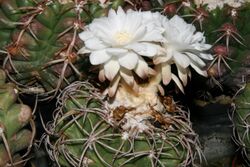Biology:Discocactus bahiensis
| Discocactus bahiensis | |
|---|---|

| |
| Scientific classification | |
| Kingdom: | Plantae |
| Clade: | Tracheophytes |
| Clade: | Angiosperms |
| Clade: | Eudicots |
| Order: | Caryophyllales |
| Family: | Cactaceae |
| Subfamily: | Cactoideae |
| Genus: | Discocactus |
| Species: | D. bahiensis
|
| Binomial name | |
| Discocactus bahiensis Britton & Rose 1922
| |
| Synonyms | |
| |
Discocactus bahiensis is a species of Discocactus from Brazil.[3]
Description
Discocactus bahiensis grows singly, with heavily spined, depressed spherical to spherical bodies that reach diameters of 8 to 18 centimeters. There are 10 to 15 ribs. The 5 to 13 backward-curved spines are up to 3 centimeters long. The prominent cephalium is formed of white wool and a few short bristles. The slender, funnel-shaped, yellowish white flowers are 4 to 5 centimeters long. The fruits are small.[4]
Subspecies
- Discocactus bahiensis subsp. bahiensis
- Discocactus bahiensis subsp. gracilis P.J.Braun & Esteves
Distribution
Discocactus bahiensis is a cactus species native to the Brazilian state of Bahia at altitudes between 380 and 650 meters.[5]
Taxonomy
It was first described in 1922 by Nathaniel Lord Britton and Joseph Nelson Rose. The species name "bahiensis" specifically denotes its presence in Bahia, Brazil.
References
- ↑ Kew), Nigel Taylor (RBG; Assessment), Pierre Braun (Global Cactus (2010-06-04). "The IUCN Red List of Threatened Species". IUCN Red List of Threatened Species. https://www.iucnredlist.org/species/40943/121437738. Retrieved 2024-01-22.
- ↑ "Appendices | CITES". https://cites.org/eng/app/appendices.php.
- ↑ "Discocactus bahiensis in Tropicos". http://www.tropicos.org/Name/5104360.
- ↑ Anderson, Edward F.; Eggli, Urs (2005) (in de). Das grosse Kakteen-Lexikon. Stuttgart (Hohenheim): Ulmer. ISBN 3-8001-4573-1.
- ↑ "Discocactus bahiensis". 2013-08-04. http://www.llifle.com/Encyclopedia/CACTI/Family/Cactaceae/31323/Discocactus_bahiensis.
External links
Wikidata ☰ Q241479 entry
 |


